中医英语翻译概论精选共33页文档
- 格式:ppt
- 大小:4.63 MB
- 文档页数:70
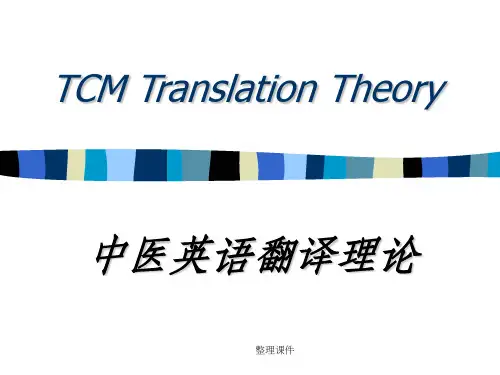
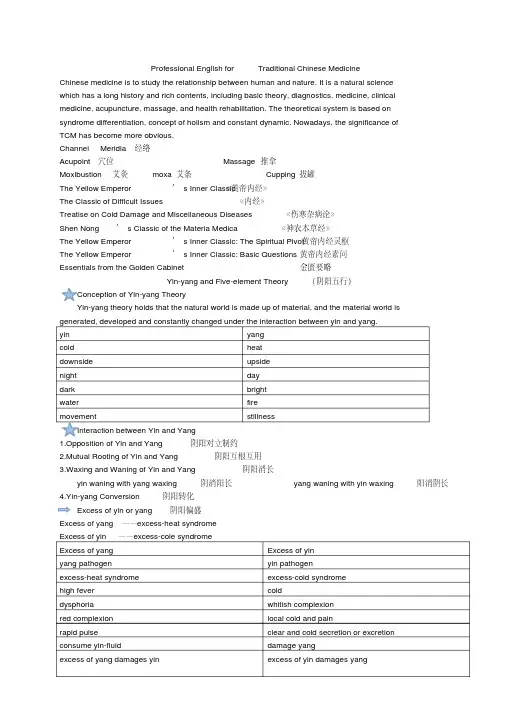
Professional English for Traditional Chinese MedicineChinese medicine is to study the relationship between human and nature. It is a natural sciencewhich has a long history and rich contents, including basic theory, diagnostics, medicine, clinicalmedicine, acupuncture, massage, and health rehabilitation. The theoretical system is based onsyndrome differentiation, concept of holism and constant dynamic. Nowadays, the significance ofTCM has become more obvious.Channel Meridia经络Acupoint穴位Massage推拿Moxibustion艾灸moxa艾条Cupping拔罐《黄帝内经》The Yellow Emperor’s Inner ClassicThe Classic of Difficult Issues 《内经》Treatise on Cold Damage and Miscellaneous Diseases 《伤寒杂病论》Shen Nong’s Classic of the Materia Medica 《神农本草经》The Yellow Emperor’s Inner Classic: The Spiritual Pivot 黄帝内经灵枢The Yellow Emperor’s Inner Classic: Basic Questions 黄帝内经素问Essentials from the Golden Cabinet 金匮要略Yin-yang and Five-element Theory(阴阳五行)Conception of Yin-yang TheoryYin-yang theory holds that the natural world is made up of material, and the material world is generated, developed and constantly changed under the interaction between yin and yang.yin yangcold heatdownside upsidenight daydark brightwater firemovement stillnessInteraction between Yin and Yang1.Opposition of Yin and Yang 阴阳对立制约2.Mutual Rooting of Yin and Yang 阴阳互根互用3.Waxing and Waning of Yin and Yang 阴阳消长yin waning with yang waxing 阴消阳长yang waning with yin waxing 阳消阴长4.Yin-yang Conversion 阴阳转化Excess of yin or yang 阴阳偏盛Excess of yang——excess-heat syndromeExcess of yin ——excess-cole syndromeExcess of yang Excess of yinyang pathogen yin pathogenexcess-heat syndrome excess-cold syndromehigh fever colddysphoria whitish complexionred complexion local cold and painrapid pulse clear and cold secretion or excretionconsume yin-fluid damage yangexcess of yang damages yin excess of yin damages yangDeficiency of yin or yang 阴阳偏衰Deficiency of yang——syndrome of deficiency-coldDeficiency of yin——deficiency-heat syndromeDeficiency of yin Deficiency of yindriving and warming actions moistening and nourishing actionsinsufficiency of Yang shortage of yincold heatdeficiency-cold deficiency-heatsyndrome of deficiency-cold syndrome of deficiency-heat”reducing excess”.实者泻之热者寒之”treating heat with cold”.”treating cold with heat”.寒者热之虚者补之”supplementing deficiency”.阴阳学说yin-yang theory 治疗原则therapeutic principle阳中之阴yin within yang 阴、阳实excess of yin or yang阴阳对立opposition of yin and yang 阴、阳虚deficiency of yin or yang阴阳交感interaction of yin and yang 虚寒证syndrome of deficiency-cold阴阳互根mutual rooting of yin and yang 泻实reducing excess阴阳消长waning and waxing of yin and yang 补虚supplementing deficiency阴阳转化yin-yang conversion 四性four properties阴阳平衡yin-yang balance 五味five flavors阴阳调和yin-yang harmony 四种运动形式four acting tendenciesConception of Five-element TheoryFive-element theory holds that all things in the natural world can be derived fromwood,fire,earth,metal and water and maintain a harmonious balance through the activities ofconstant inter-generation and inter-restriction among them.Characteristics of the five elementsThe characteristics of wood: growth,smoothness and regulation(生长、升发、条达、舒畅).木曰曲直。
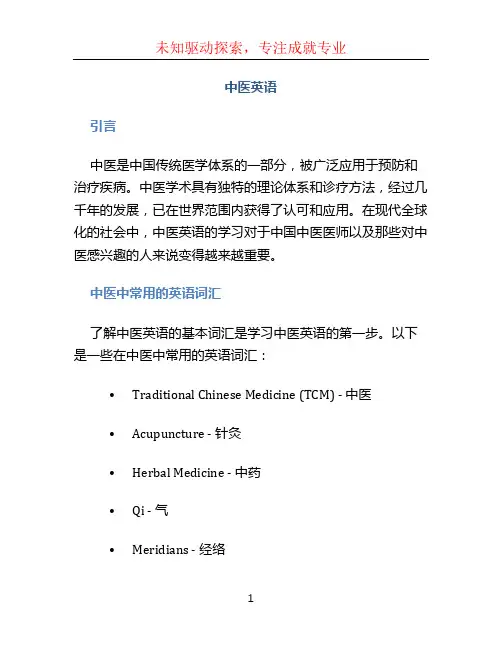
中医英语引言中医是中国传统医学体系的一部分,被广泛应用于预防和治疗疾病。
中医学术具有独特的理论体系和诊疗方法,经过几千年的发展,已在世界范围内获得了认可和应用。
在现代全球化的社会中,中医英语的学习对于中国中医医师以及那些对中医感兴趣的人来说变得越来越重要。
中医中常用的英语词汇了解中医英语的基本词汇是学习中医英语的第一步。
以下是一些在中医中常用的英语词汇:•Traditional Chinese Medicine (TCM) - 中医•Acupuncture - 针灸•Herbal Medicine - 中药•Qi - 气•Meridians - 经络•Yin and Yang - 阴阳•Five Elements - 五行•Diagnosis - 诊断•Treatment - 治疗•Moxibustion - 艾灸•Cupping - 拔罐•Tuina - 推拿这些词汇是中医英语学习的基础,掌握这些词汇将有助于更好地理解和学习中医理论与实践。
学习中医英语的方法学习中医英语的方法可以根据个人的学习习惯和需求来选择。
以下是一些常用的学习方法:1. 阅读中医相关的英文文献通过阅读中医相关的英文文献,可以了解到中医在国际上的研究和应用情况。
这不仅可以扩大中医的视野,还可以学习到更多的中医英语表达方式和专业术语。
2. 参加中医英语培训课程目前有一些机构提供中医英语培训课程,这些课程旨在帮助学习者更好地掌握中医英语,培养中医领域的英语表达能力。
通过参加这些课程,学习者可以学到专业的中医英语术语和表达方式,并且有机会与其他学习者一起进行交流和讨论。
3. 听力练习和口语训练通过听力练习和口语训练,可以提高中医英语的听说能力。
可以选择听一些中医英语的录音材料,如中医讲座或病例讨论,同时可以模仿并练习中医英语的口语表达。
4. 参与中医英语论坛和讨论参与中医英语论坛和讨论是锻炼中医英语写作能力的好方法。
可以加入一些中医英语的社群或在线论坛,与他人交流和分享中医知识,同时也可以提问和回答问题,提升自己的写作水平。
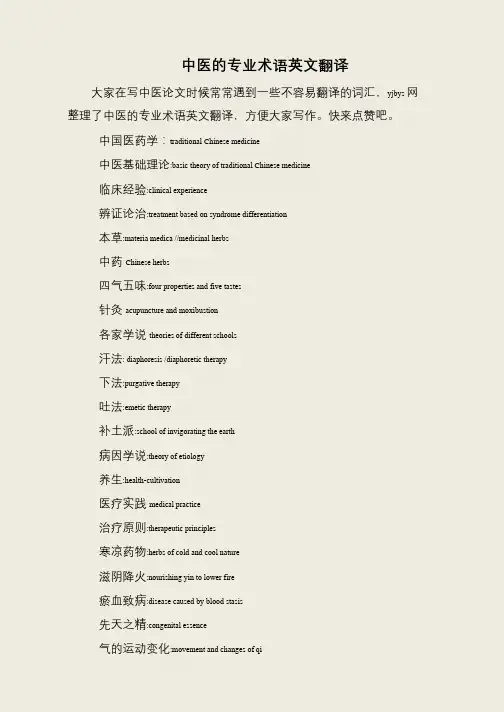
中医的专业术语英文翻译大家在写中医论文时候常常遇到一些不容易翻译的词汇,yjbys 网整理了中医的专业术语英文翻译,方便大家写作。
快来点赞吧。
中国医药学:traditional Chinese medicine中医基础理论:basic theory of traditional Chinese medicine临床经验:clinical experience辨证论治:treatment based on syndrome differentiation本草:materia medica //medicinal herbs中药Chinese herbs四气五味:four properties and five tastes针灸acupuncture and moxibustion各家学说theories of different schools汗法: diaphoresis /diaphoretic therapy下法:purgative therapy吐法:emetic therapy补土派:school of invigorating the earth病因学说:theory of etiology养生:health-cultivation医疗实践medical practice治疗原则:therapeutic principles寒凉药物:herbs of cold and cool nature滋阴降火:nourishing yin to lower fire瘀血致病:disease caused by blood stasis先天之精:congenital essence气的运动变化:movement and changes of qi。
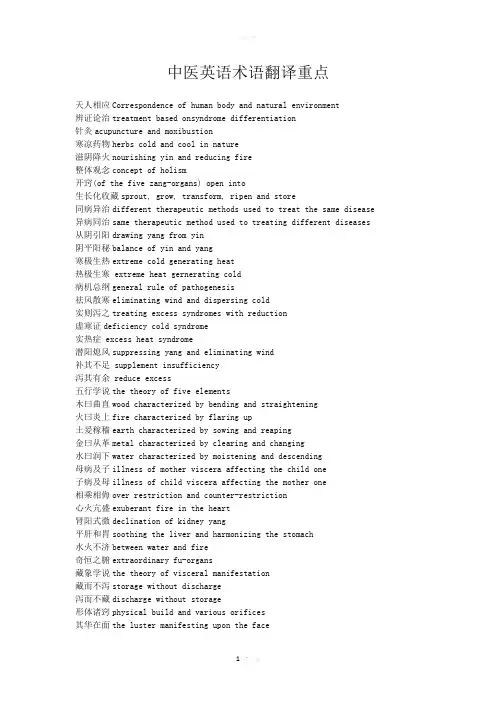
中医英语术语翻译重点天人相应Correspondence of human body and natural environment辨证论治treatment based onsyndrome differentiation针灸acupuncture and moxibustion寒凉药物herbs cold and cool in nature滋阴降火nourishing yin and reducing fire整体观念concept of holism开窍(of the five zang-organs) open into生长化收藏sprout, grow, transform, ripen and store同病异治different therapeutic methods used to treat the same disease 异病同治same therapeutic method used to treating different diseases 从阴引阳drawing yang from yin阴平阳秘balance of yin and yang寒极生热extreme cold generating heat热极生寒 extreme heat gernerating cold病机总纲general rule of pathogenesis祛风散寒eliminating wind and dispersing cold实则泻之treating excess syndromes with reduction虚寒证deficiency cold syndrome实热症 excess heat syndrome潜阳熄风suppressing yang and eliminating wind补其不足 supplement insufficiency泻其有余 reduce excess五行学说the theory of five elements木曰曲直wood characterized by bending and straightening火曰炎上fire characterized by flaring up土爰稼穑earth characterized by sowing and reaping金曰从革metal characterized by clearing and changing水曰润下water characterized by moistening and descending母病及子illness of mother viscera affecting the child one子病及母illness of child viscera affecting the mother one相乘相侮over restriction and counter-restriction心火亢盛exuberant fire in the heart肾阳式微declination of kidney yang平肝和胃soothing the liver and harmonizing the stomach水火不济between water and fire奇恒之腑extraordinary fu-organs藏象学说the theory of visceral manifestation藏而不泻storage without discharge泻而不藏discharge without storage形体诸窍physical build and various orifices其华在面the luster manifesting upon the face满而不实 full but not to be solid实而不满solid but not to be full心主血脉heart governing blood and vessels肺司呼吸lung controlling breathing脾主运化spleen governing transportation and transformation肝主疏泄liver controlling conveyance and dispersion肾主藏精kidney governing storing essence面色无华lusterless complexion汗血同源sweat and blood sharing the same origin升降出入ascending, descending, going out and going in宣发肃降dispersion, purification and descent后天之本acquired base of life肝气逆上upward adverse flow of liver qi先天之精innate essence奇恒之腑extraordinary fu-organs孤俯isolated fu-organ腐熟水谷digest water and food七冲门the seven important portals胆主决断The gallbladder is responsible for making judgment泌别清浊separating the lucid from the turbid大肠主津The large intestine governs thin body fluid小肠主液The small intestine governs thick body fluid先天禀赋innateness温养腑脏warming and nourishing the viscera津血同源body fluid and blood sharing the same origin气为血帅,血为气母Qi commands the blood and the blood carries qi.益气固脱nourishing qi to stop collapse奇经八脉eight extraordinary vessels十二经筋tendons of the twelve regular meridians舒经活络soothing meridians and activating collaterals刺络拔罐collateral pricking and cupping therapy腠理闭塞stagnation of interstitial space湿邪困脾pathogenic dampness obstructing the spleen外感六淫six excesses pathogenic factors饮食劳倦mproper diet and overstrain阳常有余,阴常不足Yang is usually excessive while yin is frequently deficient. 四大经典Four GreatClassic:Huangdi s Canon of Medicine黄帝内经Classic of Difficulties难经Shennong s Classic of Materia Medica神农本草经Rreatise on Cold Damage and Miscellaneous Diseases伤寒杂病论四气four properties:cold,,hot,warm,cool五味five flavors:sour,bitter,sweet,pungent,salty(中药)七情seven conditions of ingredients in prescriptionsSingle effect,mutual reinforcement,mutual assistance,mutual restraint,mutual inhibition,mutual antagonism,mutual suppression寒凉派Liu Wansu-School of Cold and Cool攻下派Zhang Congzheng-School of Purgation补土派Li Gao-School of Reinforcing the Earth滋阴派Zhu Zhenheng-School of Nourishing Yin辛温中药herbs pungent in taste and warm in nature辛凉中药herbs pungent in taste and cool in narure向日为阳,背日为阴The side facing the sun belongs to yang and the reverse side to yin,血液常行的前提条件:心气充沛,血液充盈,脉道通利Normal circulation of blood:abundance of heart qi,sufficiency of blood,vessels are prerequisite.四气;元气primordial qi,宗气pectoral qi,营气nutrient qi,卫气defensive qi 内生五邪;内风,内寒,内湿,内燥,内火Five internal excesses;internal wind.internal cold,internal dampness,inrenal dryness,internal fire内伤七情Internal injury due to sevenemotions;joy,anger,anxiety,thought,sorrow,fear,fright怒则气上,喜则气缓,悲则气消,恐则气下,惊则气乱。
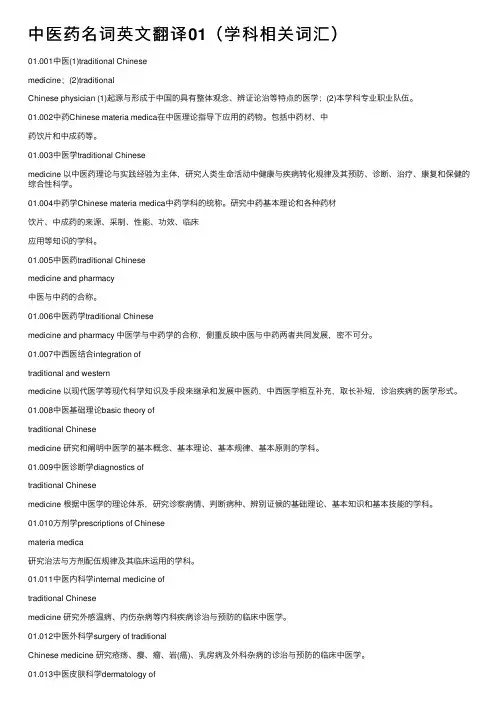
中医药名词英⽂翻译01(学科相关词汇)01.001中医(1)traditional Chinesemedicine;(2)traditionalChinese physician (1)起源与形成于中国的具有整体观念、辨证论治等特点的医学;(2)本学科专业职业队伍。
01.002中药Chinese materia medica在中医理论指导下应⽤的药物。
包括中药材、中药饮⽚和中成药等。
01.003中医学traditional Chinesemedicine 以中医药理论与实践经验为主体,研究⼈类⽣命活动中健康与疾病转化规律及其预防、诊断、治疗、康复和保健的综合性科学。
01.004中药学Chinese materia medica中药学科的统称。
研究中药基本理论和各种药材饮⽚、中成药的来源、采制、性能、功效、临床应⽤等知识的学科。
01.005中医药traditional Chinesemedicine and pharmacy中医与中药的合称。
01.006中医药学traditional Chinesemedicine and pharmacy 中医学与中药学的合称,侧重反映中医与中药两者共同发展,密不可分。
01.007中西医结合integration oftraditional and westernmedicine 以现代医学等现代科学知识及⼿段来继承和发展中医药,中西医学相互补充,取长补短,诊治疾病的医学形式。
01.008中医基础理论basic theory oftraditional Chinesemedicine 研究和阐明中医学的基本概念、基本理论、基本规律、基本原则的学科。
01.009中医诊断学diagnostics oftraditional Chinesemedicine 根据中医学的理论体系,研究诊察病情、判断病种、辨别证候的基础理论、基本知识和基本技能的学科。
01.010⽅剂学prescriptions of Chinesemateria medica研究治法与⽅剂配伍规律及其临床运⽤的学科。
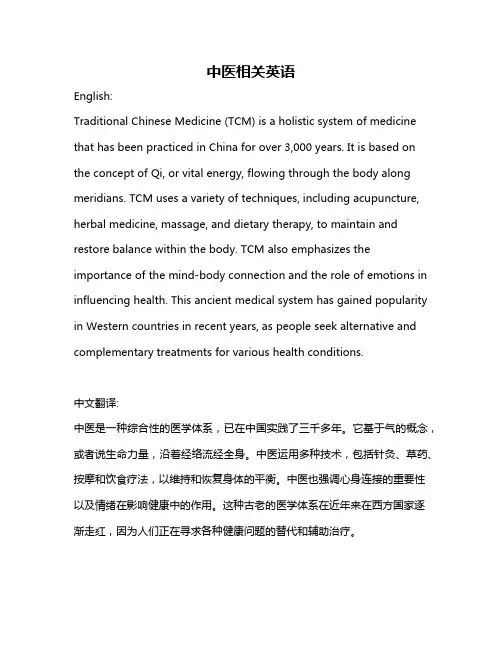
中医相关英语English:Traditional Chinese Medicine (TCM) is a holistic system of medicine that has been practiced in China for over 3,000 years. It is based on the concept of Qi, or vital energy, flowing through the body along meridians. TCM uses a variety of techniques, including acupuncture, herbal medicine, massage, and dietary therapy, to maintain and restore balance within the body. TCM also emphasizes the importance of the mind-body connection and the role of emotions in influencing health. This ancient medical system has gained popularity in Western countries in recent years, as people seek alternative and complementary treatments for various health conditions.中文翻译:中医是一种综合性的医学体系,已在中国实践了三千多年。
它基于气的概念,或者说生命力量,沿着经络流经全身。
中医运用多种技术,包括针灸、草药、按摩和饮食疗法,以维持和恢复身体的平衡。
中医也强调心身连接的重要性以及情绪在影响健康中的作用。
这种古老的医学体系在近年来在西方国家逐渐走红,因为人们正在寻求各种健康问题的替代和辅助治疗。
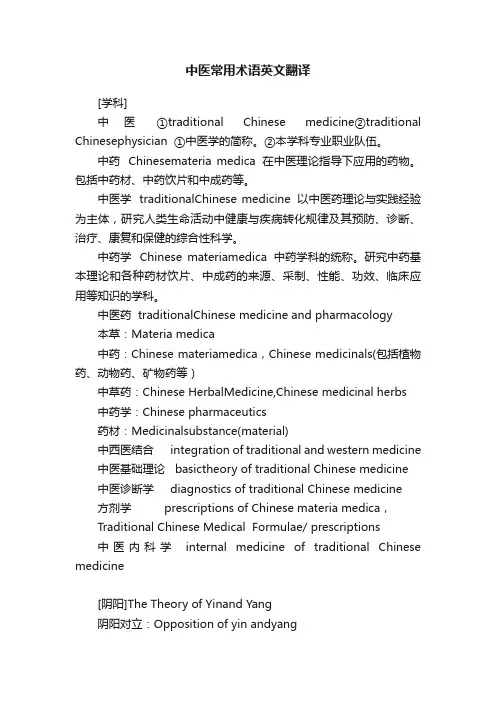
中医常用术语英文翻译[学科]中医①traditional Chinese medicine②traditional Chinesephysician ①中医学的简称。
②本学科专业职业队伍。
中药Chinesemateria medica 在中医理论指导下应用的药物。
包括中药材、中药饮片和中成药等。
中医学 traditionalChinese medicine 以中医药理论与实践经验为主体,研究人类生命活动中健康与疾病转化规律及其预防、诊断、治疗、康复和保健的综合性科学。
中药学Chinese materiamedica 中药学科的统称。
研究中药基本理论和各种药材饮片、中成药的来源、采制、性能、功效、临床应用等知识的学科。
中医药 traditionalChinese medicine and pharmacology本草:Materia medica中药:Chinese materiamedica,Chinese medicinals(包括植物药、动物药、矿物药等)中草药:Chinese HerbalMedicine,Chinese medicinal herbs中药学:Chinese pharmaceutics药材:Medicinalsubstance(material)中西医结合 integration of traditional and western medicine 中医基础理论 basictheory of traditional Chinese medicine 中医诊断学 diagnostics of traditional Chinese medicine 方剂学 prescriptions of Chinese materia medica,Traditional Chinese Medical Formulae/ prescriptions中医内科学 internal medicine of traditional Chinese medicine[阴阳]The Theory of Yinand Yang阴阳对立:Opposition of yin andyang阴阳制约:Restriction of/between yin and yang阴阳互根:Interdependence ofyin and yang阴阳消长:Waxing and waning ofyin and yang阴阳转化:Inter-transformationof yin and yang[五行学说]The Theory of FiveElements五行:water,fire,wood,metal,soil生:promote, generate,engender克: act, restrict,restrain乘:overact,over-restrict, over-restrain, subjugate, overwhelm侮:counteract,counter-restrict, counter-restrain, rebel[整体观念] concept of organicwholeness辩证法 dialectics生长化收藏 sprouting, growth,transformation,ripening,storage内外环境统一性 the unity betweenthe internal and external environments机体自身整体性 the integrity of thebody itself古代唯物论和辩证法 classic Chinesematerialism and dialectics 矛盾统一the contradictoryunity互相联系、相互影响related to each otherand influence each other标本 Biao (secondaryaspect) and Ben (primary aspect)本质与现象nature and phenomena矛盾的普遍性和特殊性universality andspeciality of contradictions寒者热之Cold disease shouldbe treated by warm therapy热者寒之warm disease shouldbe treated by cold therapy虚者补之deficiency syndromeshould be treated by tonifyingtherapy实者泻之excess syndromeshould be treated by purgation therapy治病必求其本 Treatment ofdiseases must concentrate on the root cause同病异治treatment ofthe same disease with different therapeutic methods异病同治treatment ofdifferent diseases with the same therapeutic method[精气神]清阳为天 The lucid Yangascends to form the heaven浊阴为地 The turbid Yindescends to constitute the earth气化 Qitransformation升降出入 ascending,descending, going out, coming in出入废则神机化灭,升降息则气立孤危。
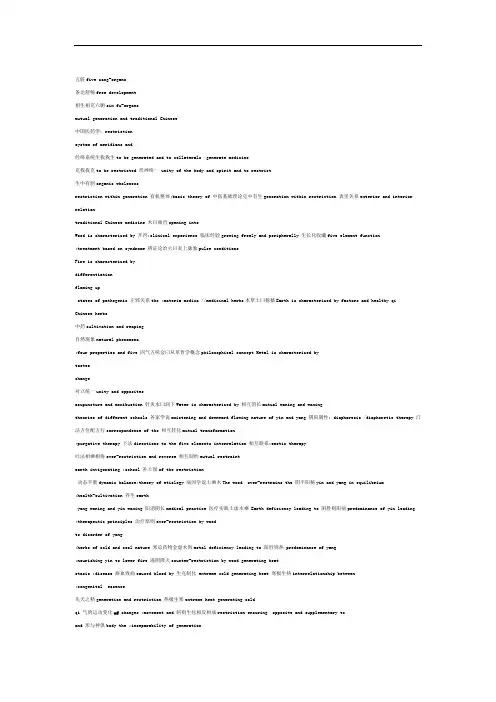
五脏five zang-organs条达舒畅free development相生相克六腑six fu-organsmutual generation and traditional Chinese中国医药学:restrictionsystem of meridians and经络系统生我我生to be generated and to collaterals generate medicine克我我克to be restricted 形神统一 unity of the body and spirit and to restrict生中有制organic wholenessrestriction within generation 有机整体:basic theory of 中医基础理论克中有生generation within restriction 表里关系exterior and interior relationtraditional Chinese medicine 木曰曲直opening intoWood is characterized by 开窍:clinical experience 临床经验growing freely and peripherally 生长化收藏five element function:treatment based on syndrome 辨证论治火曰炎上脉象pulse conditionsFire is characterized bydifferentiationflaming upstates of pathogenic 正邪关系the :materia medica //medicinal herbs本草土曰稼穑Earth is characterized by factors and healthy qi Chinese herbs中药cultivation and reaping自然现象natural phenomena:four properties and five 四气五味金曰从革哲学概念philosophical concept Metal is characterized bytasteschange对立统一unity and oppositesacupuncture and moxibustion 针灸水曰润下Water is characterized by 相互消长mutual waning and waxingtheories of different schools 各家学说moistening and downward flowing nature of yin and yang 阴阳属性: diaphoresis /diaphoretic therapy 汗法方位配五行correspondence of the 相互转化mutual transformation:purgative therapy 下法directions to the five elements interrelation 相互联系:emetic therapy吐法相乘相侮over-restriction and reverse 相互制约mutual restraintearth invigorating :school 补土派of the restriction动态平衡dynamic balance:theory of etiology 病因学说土乘木The wood over-restrains the 阴平阳秘yin and yang in equilibrium:health-cultivation 养生earthyang waning and yin waxing 阳消阴长medical practice 医疗实践土虚木乘 Earth deficiency leading to 阴胜则阳病predominance of yin leading :therapeutic principles 治疗原则over-restriction by woodto disorder of yang:herbs of cold and cool nature 寒凉药物金虚木侮metal deficiency leading to 阳胜则热 predominance of yang:nourishing yin to lower fire 滋阴降火counter-restriction by wood generating heatstasis :disease 瘀血致病caused blood by 生克制化 extreme cold generating heat 寒极生热interrelationship between:congenital essence先天之精generation and restriction 热极生寒extreme heat generating coldqi 气的运动变化of changes :movement and 制则生化相反相成restriction ensuring opposite and supplementary toand 形与神俱body the :inseparability of generationeach otherspirit传变physiological functions transmission of disease 生理功能 spirit/mental activity:神明母病及子disease of the mother-organ 病理变化pathological changes:zang-organs and fu-organs/viscera 脏腑affecting the child-organ临床诊断clinical diagnosis:functional activities 功能活动子病犯母organic wholeness/entirety 有机整体disease of the child-organ:unity of the body and spirit 形神统一affecting the mother-organbetween 正邪斗争struggle healthy qi and:imbalance of yin and yang 阴阳失调肝肾精血不足insufficiency of kidney pathogenic factorsand:struggle between healthy qi 正邪相争liver essence and blood绝对偏盛absolute predominanceand pathogenic factors 肝阳上亢deficiency yang 阳虚则寒hyperactivity of liver yang cold leading toprevention of disease 治未病藏象学说consumption of yang involving 阳损及阴 theory of visceralto cultivate health 调养manifestationsyinhealthy qi 正气五脏六腑insufficiency of yin-fluid 阴液不足 five zang-organs and sixpathogenic factor病邪fu-organs病机pathogenesisprevention and treatment of 疾病的防治奇恒之府五行学说theory of five elements extraordinary fu-organsdiseasecereal nutrients水谷精微motion and variation运动变化 concept of holism整体观念.传化水谷 transmissions and 潜阳息风suppressing yang to quench wind and pathology of the human body as wellas the diagnosis, prevention and interdependence of yin transformation of food 阴阳的互根互用treatment of disease.storage of essence and yang贮藏精气4. interior and exterior interdependence黄帝内经总结了春秋战国以来的医疗成相互依存表里关系就和治疗经验,确立了中医学独特的理论体relationship阴阳离决separation of yin and yang系,成为中医药学发展的基础。
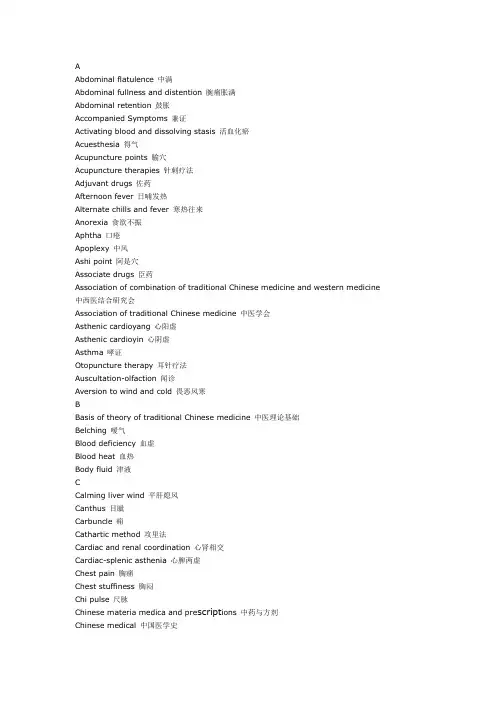
AAbdominal flatulence 中满Abdominal fullness and distention 腕痛胀满Abdominal retention 鼓胀Accompanied Symptoms 兼证Activating blood and dissolving stasis 活血化瘀Acuesthesia 得气Acupuncture points 腧穴Acupuncture therapies 针刺疗法Adjuvant drugs 佐药Afternoon fever 日哺发热Alternate chills and fever 寒热往来Anorexia 食欲不振Aphtha 口疮Apoplexy 中风Ashi point 阿是穴Associate drugs 臣药Association of combination of traditional Chinese medicine and western medicine 中西医结合研究会Association of traditional Chinese medicine 中医学会Asthenic cardioyang 心阳虚Asthenic cardioyin 心阴虚Asthma 哮证Otopuncture therapy 耳针疗法Auscultation-olfaction 闻诊Aversion to wind and cold 畏恶风寒BBasis of theory of traditional Chinese medicine 中医理论基础Belching 嗳气Blood deficiency 血虚Blood heat 血热Body fluid 津液CCalming liver wind 平肝熄风Canthus 目眦Carbuncle 痈Cathartic method 攻里法Cardiac and renal coordination 心肾相交Cardiac-splenic asthenia 心脾两虚Chest pain 胸痛Chest stuffiness 胸闷Chi pulse 尺脉Chinese materia medica and pre script ions 中药与方剂Chinese medical 中国医学史Chinese medicine anesthesia 中药麻醉Chinese patent drugs 中成药Clear abundant urine 小便清长Clearing damp 利水渗湿Clearing heat and expectoration 清热化痰Clearing wind-damp 祛风胜湿Clearing Ying heat and cooling blood 清营凉血Coating color 苔色Cold hands and feet 手足厥冷Cold-heat mixing 寒热交错Cold limbs 手足厥冷Cold stroke 中寒Coma 神昏Compendium of Materia Medica 本草纲目Complications 并病Constipation 大便不通Consumptive disease 虚劳Contrary treatment 反治DDefensive Qi instability 卫气不固Deficiency-excess mixing 虚实夹杂Delirium 谵语Diagnostic methods of traditional Chinese medicine 中医诊法Diaphoresis 汗法Diaphoresis, pungent cold 辛凉解表Diaphoresis, pungent warm 辛温解表Diarrhea 泄泻Different treatments for the same disease 同病异治Differentiation, eight principles 八纲辨证Differentiation of diseases 辨病Differentiation of symptoms and signs 辨证Differentiation, six meridians 六经辨证Differentiation, triple energizer 三焦辨证Differentiation, Wei-Qi-Ying-Xue 卫气营血辨证Differentiation, Zang-Fu 脏腑辨证Diphtheria 白喉Diseases of Qi-blood-fluid 气血津液病症Dispersing cold and freeing Bi 散寒通痹Doctrines of various historical schools 中医各家学说Dry heat 燥热Dry stool 大便干结Dysentery 痢疾Dyspepsia 食滞Dysphagia 噎膈Dyspnea 喘证Dysuria 癃闭EEdema 水肿Eight principles 八纲Electuary 冲服剂Elimination 消法Emesis 吐法Endogenous hygrosyndrome 内湿Endogenous cold 内寒Endogenous dryness 内燥Epilepsy 痫证Epitaxis 鼻衄Eruption 斑疹Etiology 病因Exterior syndrome 表证Exterior sthenia 表实Exterior asthenia 表虚Extremely cold limbs 手足厥逆FFacial distortion 口眼歪斜Feeling 按诊Fluid deficiency 津液不足Frequent micturition 小便频数Frequent vomiting 反胃GGastric asthenia 胃虚Gastric cavity 胃脘Gastro-Qi 胃气Generation-inhibition in five elements 五行相克Gingiva 牙龈Greyish fur 灰苔HHarmonizing liver-spleen 调和肝脾Heart fire hyperactivity 心火亢盛Heart-kidney Yang deficiency 心肾阳虚Heart Yang hypoactivity 心阳不振Healthy Qi 正气Hectic fever 潮热Hemorrhage Zheng 血证IInsomnia 失眠Inspection 望诊Intergeneration 相生Inter-restriction 相克Inter-subjuation 相乘Irregular pulse 结代脉KKidney Yang deficiency 肾阳虚Kidney Yin deficiency 肾阴虚LLarge intestine damp-heat 大肠湿热Large pulse 大脉Leukorrhea 白带Liver fire flaming 肝火上炎Liver-stomach disharmony 肝胃不和Liver wind agitation 肝风内动Liver Yang rising 肝阳上亢Liver Yin deficiency 肝阴虚Long pulse 长脉Longer menstrual interval 月经后期Loose stool 便溏Lung heart 肺热Lung Qi deficiency 肺气虚Lung Qi impairment 肺气失宣MMeasles 麻疹Menstrual irregularities 月经失调Merdian-collateral theory 经络学说Meridial distribution 归经Mutual promotion 相须NNight sweat 盗汗Nine orifices 九窍Normal pulse 平脉Nourishing blood and liver 养血柔肝PPale tongue 淡白舌Palpation 切诊Palpitation 心悸Pathogenesis 病机Peeled coating 剥脱苔Pestilence 疫疠Pharynx neurosis 梅核气Phlegm-damp obstructing lung 痰湿阻肺Pill 丸Pores 玄府Principal and subordinate 标本Pulse condition 脉象Pulse-taking 脉诊Purgation-tonifying 攻补兼施QQi-blood and fluid 气血津液Qi deficiency 气虚Qi depression 气滞Qi function 气机RRapid pulse 数脉Relaxing bowels 润肠通便Removing stasis to promote blood circulation 化瘀行血Resolving damp, aromatic 芳香化湿Resuscitation 开窍Retch 干呕Reverse restriction 相侮SSchool in favour of the doctrine of warm diseases 温病学派School of febrile diseases by cold injury 伤寒学派Scrofula 瘰疬Sighing 太息Smallpox 天花Somnolence 多寐Sore 疮Spleen Qi deficiency 脾气虚Spleen Yang deficiency 脾阳虚Spleen Yin deficiency 脾阴虚Spontaneous sweating 自汗Stranguria 小便涩痛Stomach cold 胃寒Stomach heat 胃热Strengthening healthy energy 扶正Striae 腠理Stringy pulse 弦脉Sunstroke 中暑TTenesmus 里急后重Tonifying deficiency 虚则补之Tonifying kidney and holding Qi 补肾纳气Tonifying Qi and spleen 益气健脾Treating excess with purgation 实则泻之Treatment with syndrome differentiation 辨证论治Twenty-eight pulses 二十八脉UUlcer 溃疡Urinal incontinence 小便失禁Uterus 女子胞VVitaport 命门WWhitish fur 白苔Whooping cough 百日咳YYellowish fur 黄苔Ying and Yang in balance 阴平阳秘ZZheng 证一阳"frist yang, Shaoyang Channel"一阴"frist yin, Jreyin Channel"一逆one mista ade in treatment一息respiration一侧的unilateral一日量daily dose一服药a dose of medicine一夫法finger breadth measurement一身痛重general pain and heaviness乙癸同源Yi(the live) and Gui)the Kidney) bejing the same source二阴"two lower orifices, ie, the external urethral orifice and the anus" 二浊reddish and whitish turbid urine二十八脉twenty-eight kinds of pulse condition二阳并病Shaoyang syndrome complicated by T aiyang syndrome二便不利difficulty in urination and defecation二便失禁urinary and fecal incontinence十问inquire about ten aspects of the patient十剂ten kinds of pre script ion十八反eighteen incompatible medicaments十二剂twelve kinds of pre script ion十二节twelve joints十二禁twelve contraindications十二经twelve regular channels十二时traditional twelve two-hour periods十二脏twelve internal organs十二怪脉"ten moribund pulses, ten kinds of paradoxical pulse condition" 十九畏nineteen nedicaments of nutual antagonism十三科the thirteen medical specialties十四经the fourteen channels十五络(脉)fifteen main collaterals十二节刺twelve methods of needling十二经别branches of the twelve regular channels十二经筋muscle along the twelve regular channels十二皮部twelve skin areas十六郄穴sixteen cleft points十四经穴"accupuncture points on the fourteen regular channels, acupoints on regular channels"十五络穴fifteen main collaterals points十二经动脉arteries of the twelve channels十二井穴twelve well-points十二经之海sea of the twelve channels丁痂scar丁奚疳infantile malnutrition due to excessive feeding丁躬势bowing丁字形骨折T-shaped fracturre七方"seven pre script ions, Seven formulae"七恶the symtoms and signs indicating poor prognosis of suppurative infections of the exterior part of the body七窍seven orifices七情seven emotions七疝seven kinds of hernia七伤 1.seven kinds of impairments 2.seven symptoms suggesting consumption of the kidney-qi七冲门seven important portals七怪脉"seven moribund pulses, seven paradoxical pulse conditions, seven fatal pulse conditions"七日风=脐风neonatal tetanus七星针=梅芬针seven star needle八纲the eight principal syndromes serving as guidelines in diagnosis八法eight therapeutic methods八廓the eight regions of the white of the eye八溪eight joints八会穴"eight hui-points, eight influential points"八片锦different pictures of superficial venules of index finger in children as a reference for diagnosis八纲辨证analyzing and differentiating pathological conditions in accordance with the eight principal syndromes八脉交会穴eight confluence points人中疔boi on philtrum人咬伤human bite; bite by man人迎脉Renying pulse人背复位back-carrying reduction人痘接种human variolation人工牛黄"artificial ox gallstone, Calculus Bovis Factitius"人事不省=神昏unconsciousness入臼joint reduction儿风eclampsia儿病=恶阻儿茶"catechu, blzck catechu, Catechu"儿枕痛after-pains儿捧母心breech presentation儿科四大要证four chief diseases in pediatrics九刺nine types of needling九气nine kinds of illness due to disturbance of qi九窍nine orifices九脏nine internal organs九虫病parasitic diseases九窍出血bleeding from the nine orifices九六补泻法nini-six reinforcing-reducing method刀伤incised wound刀晕traumatic syncope刀创伤drug for incised wound刀斧伤wound by knife or ax三宝"three exxentialsessence, qi and configurative force"三痹three types of arthralgiz三刺=齐刺three-stratum puncture三法"three therapeutic methods-diaphoresis, emesis, and purgation" 三伏"1.three periods of dog days, 2.the third period of dog days"三关the three passes三焦"tri-jiao, sanjiao, triple warmer, triple heater"三毛(丛,聚)clump hair三品three grades of medicines三消three types of diabetes三因three categories etiologic factors三虫病three intestinal parasitoses三春柳=柽柳三焦病disease of tri-jiao三焦经Tri-jiao Channel三焦咳tri-jiao cough三棱针"three-deged needle, tri-ensiform needle"三陷证three typesof inward penetration of pyogenic agent三阳病disease of the three yang channels三阳经three yang channels三阳络Sanyanglo三阴病diseases of the three yin channels三阴经three yin channels三阴痉convulsion with symptoms of three yin channels三阴疟three-yin malaria三板疗法"tri-tabular massage, massage with three Kinds of boards"三部九候three portions and nine pulse-takings7 三焦辨证differentiation of syndrome according to the pathological changes of trijiao 三焦实热heat in tri-jiao of excess type三焦虚寒cold syndromes of deficiency type三阳合病disease involving all three yang channels三点挤压法three-point pressure method三焦主决渎the triple warmer manages the dredging of water pathway干便dry stool干疽cellulitis at the anterolateral aspect of the shoulder干咳"dry cough, unproductive cough"干呕retching干陷dry type of inward penetation of pyogenic agent干癣1.chronic eczema 2.neurodermatitis干皮dried bark干血劳emaciation due to blood disorders干胁痛dry hypochondriac pain干脚气dry beriberi干霍乱dr cholera干眼症xerophthalmia干拔罐1.dry cupping 2.ordinary cupping土earth(in five elements)土方"folk recipe, local recipe"土疳=针眼hordeolum土栗infection of the heel土风疮popular urticaria土生甘sweet flavour is attributed to earth土生金earth generates metal土克水earth restricts water土脯子mantis cheeks土乘水earth subjugates water土不制水earth fails to control water土生万物earth produces myriads of things土喜温燥earth prefers warmth and dryness土郁夺之Dampness accumulated in the spleen(earth) should be removed8 下胞Lower eyelid下膊forearm下法"purgation, purgative therapy"下疳chancre下膈intake of food in the morning and vomiting in the evening下工"an inferior medical worker, an inexperienced healer"下骨sending down the fishbone下极1.anus 2.perineum 3.area between inner canthi 4.another name for Hengku下焦"lower-jiao, lower warmer, lower heater, lower burner"下利diarrgea下迫tenesmus下气"1.a therapeutic mithod to keep the adverse qi flowing downward 2.aerofluxus, breaking wind 3.qu of the lower part of the body"下窍lower orifices下泉urine下乳=催乳lactogenesis下脘1.phlorus 2.Hsiawan下陷=中气下陷descending disorders下消"diabetes of the kindney type, diabetes incolving the lower-jiao"下搭手lower back cellulitis下丹田lower elixir field下发背"lumbar carbuncle, deep-rooted ulcer in the lumbar region"下焦病lower-jiao syndrome下马痈acute pyogenic infection of right下石疽indurated mass of knee下牙床mandible下注疮eczema of shank下病上取treating diseases of the lower part of the body by needling points on the upper part of the body下腹胀气flatulence in the lower abdomen下汲肾阴consumption of the kidney-yin by the excessive heart fire下焦如渎lower-jiao resembling water passages下焦主出The Lower-jiao is in charge of excretory system下厥上竭exharstion of blood with cold limbs下厥上冒dizzeness caused by adverse flow of qi下利清谷diarrhea with undigested food in the stool下损及上dusease in the lower part affecting the upper下胎毒法dispelling toxic heat and meconium gathered at the fetus for the new born下者举之Sinking disorders should be treated with drugs of raising property; prolapse and ptosis must be treated with the lifting method to reinforce the vital function of the spleen 下焦湿热downward flow of damp and heat下利赤白dysenteric diarrhea下横骨伤fracture of public bone下行通路descending pathway 最新回复zzzxxx001 at 2007-7-06 22:45:43大夫"an official's title in the feudal age, now used for a doctor in northern China"大肠large intestine大毒extremely poisonous drugs大方heavy pre script ion大分distinct line between large muscles大风= 麻风大腹upper abdomen大谷large space between muscles大汗"profuse sweating, byperhidrosis, excessive perspiration"大经rge channels 2.the needling of points on a large channel exhibiting symptoms 大厥coma大络large collatereals大脉"large pluse, gigantic pulse"10 大衄profuse bleeding from the mouth and nose大气"atmosphere, air"大溲(解)"defecation, bowel movements"大泻vigorous reduction大医respected doctor大针large needle大眦=内眦great canthus大节large joints大产eutocia大便feces; stool;defecation大耳mycrotia大肉large muscles大嘴macrostomia大肠病disease of large intestine大肠经"Large Intestine Channel, LI"大肠虚asthenia of large intestine大肠痈acute appendictis大肠胀flatulence of large intestine大方科speciality of internal medicine大瘕泄dysentery大结胸large accumulation of phlegm-heat in the chest大头垫megacaput pad大头风=大头瘟infection with swollen head大腿疽=股疽大腿痈carbuncle of thigh大泻刺drainage needling大指间web of great toe大周天large cirde of vital energy大眦漏=漏睛dacryocystitis大方脉adult's pulse大出血"massive hemorrhage,hematorrhea"大肠气inguinal hernia大麻风"lepra, leprosy"大便溏loose stool大补元气invigorating primodial qi大肠寒结constipation due to retention of cold-pathogen in large intestine大肠滑脱prolapse of rectum大肠气滞qi stagnation of large intestine大肠热结large intestinal11 大肠湿热large intestinal damp-heat大肠虚寒asthenia-cold of large intestine大肠液亏deficiency of fluid in large intestine大方脉科internal medicine大风恶疫=麻风大肉陷下obvious emaciation and muscular atrophy大头伤寒=大头瘟大眦脓漏dacryocystitis with pyorrhea大气疗法aerotherapy大风荷毒most dangerous pathogenic factors大肠津亏fluid deficiency in the large intestine大便干结dry stool大便不通constipation大便色黑"black stool, melena"大便如漆tarry stools大便失禁incontinence of feces大便困难dyschesia大便频数frequency of bowel movement大汗淋漓profuse perspiration大骨枯槁bones become dry and brittle大渴引饮extreme thirst大肠主传导large intestine takes charge of transportation大实有羸状appearance of deficiency in extreme excess兀兀欲吐intense nausea万灵药panacea寸a length measurement corresponding to the middle segment of one's middle finger 寸脉cun pulse寸口脉cunkou pulse寸白虫proglottid of tapeworm寸白虫病taeniasis寸、关、尺"cun,guan,and chi,inch,bar,and cubit"上胞upper eye lid上膊upper arm上膈"postcibal vomiting,vomiting immediately after in gestion"12 上工"Shang-gong,superior medical worker"上火sufering from excessive internal heat上焦"upper-jiao,upper warmer,upper heater"上气1.abnormal rising of qi 2.the upper qi上窍upper orifices上脘1.shangwan 2.episgastrium上消diabetes involving the upper-jiao上搭手cellulitis near the scapular region上丹田upper elixir field上腭痈abscess on palate上耳背Shangerpei上发背suppurative inflammation of the uppermost part of the back上横骨sternal notch上马痈left buttock carbuncle上石疽upper stony mass behind the ear上水鱼abscess of the popliteal region上牙床upper dental bed上肢瘫paralysis of upper extremities上焦证upper warmer syndrome上胞下垂"ptosis,blepharoptosis"上病下取treating diseases in the upper part by managing the lower上膈下膈upper stenosis and lower stenosis上寒下热cold in the upper and heat in the lower上焦病症syndrome of the upper-jiao上焦如雾the upper-jiao resembling a sprayer上焦主纳The upper-jiao is in charge of receiving上骱手法reduction of dislocation上厥下竭syncope due to exhaustion below上气喘促shortness of breath上热下寒heat in the upper and cold in the lower上实下虚excess in the upper and deficiency in the lower上损及下the upper effecting the lower上吐下泻vomiting and diarrhea上下配穴"coordination of the acupionts of the upper with those of the lower, superior-inferior point association"上虚下实deficiency in the upper and excess in the lower上肢不遂moter impairment of the upper extremities上翘下钩势dorso-extension and ventro-flexion exercise口"mouth,oral cavity"口臭"foul breath, halitosis"口疮"aphthae,canker sore"口淡tastelessness口服"per oral,per os"口疳aphthae in children口紧=唇紧口噤"lockjaw, trismus"口苦bitter taste口软flaccidity of mouth in infants口水"saliva,spittle"口酸sour taste口{口呙} wry mouth口咸salty taste口吃"stutter,stammer"口糜erosion of mucous membrance of the oral carity口渴thirst口不仁numbness of mouth口齿科specialty of stomatology and dentistry口甘甜sweet taste口疳风=舌头泡blisters of the tongue口丫疮"ulcer on the angle of lips,perleche"口中和normal sense of mouth口臭口烂halitosis and aphthosis口唇发紫cyanotic lips口唇紧缩=唇紧口干唇裂dry mouth with cracked lips口噤唇青trismus with cyanotic lips口舌糜烂aphthous stomatitis14 口涎外溢"1.involuntary drooling 2.sialorrhea,ptyalism,sialism,excessive flow of saliva" 口眼{口呙}斜"1.facia hemiparalysis deviation of the eye and mouth, wry mouth with distorted eyes"口中无味=口淡flat feeling in mouth口干唇燥dry mouth and lips口不知谷味loss of appetite口齿咽喉科"1.Department of the Mouth, Teath and Throat 2.specialty of mouth tooth-throat" 口沃沫多唾excessive salivation with froth千日疮verruca vulgaris千岁疮=流注疮widespread scrofula久咳chronic cough久痢protracted drsentery久疟chronic malaria久痔=肛漏recto-analfistula久泻chronic diarrhea久热伤阴persistent fever injuring yin essence久不受孕fail to be impregnated for a long time久泻不止chromic diarrhea丸剂"pill,bolus"广肠sigmoidorectum广疮=杨梅疮syphilis广明anterosuperior part of the human body丫叉毒丫刺毒pustule in the web between the fiest and second metacarpals亡血"hemorrhage, bleading"亡阳"yang depletion,yang exhaustion"亡阴"yin depletion,yin exhaustion"亡血家patient with hemorrhagic diathesis尸厥corpse-like syncope尸体"corpse,cadaver"尸咽"ophthalmo-oro-genital syndrome,Behcet's syndrome"卫defensive function卫气defensive energy卫分证" weifen syndrome,febrile disease at wei phase,syndrom of wei system"卫生局"health bureau, sanitary bureau"卫生学sanitary science卫气不固=表气不固wei-energy fail to protect the body卫气同病"syndrome of both weifen and qufen,syndrome of both qi and wei systems"卫气管血辨证analysing and differentiating the development of an epidemic febrile disease by studying condition of the four systems女科"1.women's diseases,gynecology and obster\trics 2.medical department for women,department of gyhecology and obstetrics"女医1.woman physician 2.physician who attends to women's diseases女劳疸jaundice due to sexual intemperance女劳复relapse of disease due to intemperance in sexual life女子胞uterus女阴溃疡ulcerative vulvitiszzzxxx001 at 2007-7-06 22:46:39小产"abortion, miscarriage"小肠the small intestine小毒"d toxicity 2.drugs with a little toxicity,slightly poisonous drugs"小方"minor pre script ion,minor or mild pre script ion"小分small space between muscles小腹=少腹lower abdomen小逆minor mistake in treatment小溲urine小溪=溪谷小心=心包络=命门小眦"lateral canthus, external canthus"小耳microtia小眼microphthalmus小嘴microstomia小便"urine, urination, micturition"小肠病disorder of the small intestine16 小肠经=手太阳小肠经small intestine channel小肠咳"small intestine cough, cough accompanied by flatulence"小肠疝[气] hernia小肠痈small intestinal abscess小肠胀flatulence of the small intestine小方科specialty of pediatrics小腹满distension of lower addomen小夹板splintlet小结胸accumulation of phligm-heat in the chest小伤寒"common cold, common cold of wink-cold type"小舌头uvula小腿疽=胫疽leg cellulitis小中风faint小周天a small circle of the evolutive小眦漏fistula in the lateral canthus小方脉infantile pulse小腹疽(痈)carbuncle of lower abdomen小便短赤scanty dark urine小便短小oliguria小便黄赤dark urine小便辣痛ardor urine小便淋沥dribbling urination小便涩痛difficulty and pain in micturition小便灼热burning sensation during urination小肠实热excessive heat in the small intestine小肠虚寒hypofunction of the small intestine with cold manifestations小儿暴惊sudden fright in children小儿表热exterior-heat syndrome in children小儿虫吐parasite vomiting in children小儿喘急dyspnea in children小儿卒利acute infantile diarrhea in children17 小儿扎目incessant winking of eyes in children小儿发热fever in children小儿发痧eruptive disease in children小儿疳眼eye disorder due to malnutrition in children小儿寒吐vomiting in children due to cold小儿脚拳1.infantile pedal spasm 2.spasm of toes in children小儿惊吐vomiting in children induced by frightening小儿咳逆choking cough in children小儿客忤convulsive seizure in duced by terror in children小儿羸瘦emaciation in children小儿里热endopathic heat syndrowme in children小儿脉法pulse-taking in children小儿热吐vomiting in children due to heat小儿实热heat syndrome of excess type in children小儿食积infantile indigestion with food retention小儿手拳contracture of fingers in children小儿瘫痪infantile paralysis小儿痰鸣wheezing cough in children小儿通睛"esotropia in children, convergent strabismus in children"小儿吐泻vomiting and diarrhea in children小儿哮喘asthma in children小儿虚热heat syndrome of deficiency type in children小儿遗溺(尿)"1.incontinence of urine in children 2.bed-wetting, nocturnal enuresis in children"小儿脉科specialty of pediatrics小户嫁痛pain in vagina小溲热赤dark urine with burning sensation小腿转筋spasm of calf小儿夜啼nocturnal fretfulness infinfants小儿疳积mallnutrition and indigestion syndrome in children18 小儿浮肿edema in children小儿痢疾dysentery in children小儿感冒common cold in children小儿痢证epilepsy in children小儿淋证infection of urinary system in children小儿风水acute glomerular小儿血虚anemia in children小儿自汗"spontaneous perspiration in children, hyperhidrosis in children"小儿咳嗽cough in children小儿腹痛abdominal pain in children小儿无耳anotia小便不利"dysuria, difficulty in micturition"小便不禁=小便失禁"incontinence of urine, aconuresis"小便淋沥dripping discharge of urine小便频数frequency of micturition小儿暑热(渴)证summer fever of children小儿痰湿吐"vomiting in children, due to phlegmdampness"小肠主受盛small intestion has a function of reception小腹中痞块mass in the lower abdomen小儿涕液不收incessant running nose in children小儿推拿疗法infantile massage小儿囟门不合non-closure of fontanels in infants小儿时行痿poliomyelitis小儿遗毒烂斑congenital syphilis飞痘pustules from smallpox vaccination飞法flying method飞疡(扬)喉hematoma of uvulla飞腾八法=灵龟八法the eight magic turttle techniques飞蚊幻视muscae volitantes叉喉风acute laryngeal disorder with compressive feeling in the throat19 马牙1.gingival cyst of mucous gland in the newborn 2.yellowish eruptions on the gum of the newborn马桶癣contact dermatitis of buttock马脾风acute asthmatic attack in children马蹄针staple puncture马刀侠瘿sabre and beadstring scuofulae马蜞咬伤bite by leech子烦restlessness during pregnancy子户=气穴子淋stranguria during pregnancy子满gestational edema子门cervical orifice of uterus子气1.qi of the child organ 2.edema of legs in pregnancy子舌=重舌子嗽=妊娠咳嗽intractable cough during pregnancy子痫(冒)eclampsia gravidarum子悬"upward flow of fetusqi, feeling of distension in the thorax during pregnancy" 子喑"gestational aphonia, aphonia during pregnancy"子痈acute or chronic orchitis and epedidymitis子脏=女子胞医学翻译子肿edema during pregnancy子宫石womb stone子宫痛uterismus子母痔prolapsed internal hemorrhoids子病及母disorder of the child organ affecting the mother organ子肠不收=子宫脱(垂)出uterine prolapse子盗母气illness of the child organ may involve the mother organ子户肿胀swelling of vulva子死腹中=死胎不下dead foetus in the uterus子午捣臼zi wu dao jiu needli绪论introduction中医学traditional Chinese medicine (TCM)中医学理论体系theory system of TCM中医基础理论basic theory of TCM整体观念holism concept五脏一体观holism of five ogans形神一体观holism of body and spirit天人一体观holism of human beings and universe医学模式medical pattern辨证syndrome differentiation论治treatment variation疾病disease证候syndrome症状symptom体征physical sign辨病disease diagnosing同病异治different treament for the same disease异病同治the same treatment for the different disease第一章中医学的哲学基础Ancient philosophic basis of TCM精jing(as the world origin in ancient philosophy)气qi(as the world origin in the ancient philosophy)精气学说theory of jingqi生命life中介medium气机qi activity气化qi transformation感应induction水地说hypothesis of jing originating from water and earth云气说hypothesis of qi originating from cloud and air气一元论monism of qi元气一元论monism of qi阴阳yinyang; yin and yang阴阳学说theory of yinyang阴阳对立inter-opposition between yin and yang阴阳互根inter-dependence between yin and yang阴阳消长wane and wax between yin and yang阴阳交感inter-induction between yin and yang阴阳互藏inter-containing between yin and yang阴阳转化inter-transformation between yin and yang阴阳自和reestablishment to yin-yang equilibrium阴阳平衡both yin and yang in equilibrium五行five elements五行学说theory of five elements五行相生inter-promotion of five elements五行相克inter-inhibition of five elements五行制化relationship of promotion and restriction of five elements 五行相乘inter-invasion of five elements五行相侮reverse restriction in five elements五行胜复resistance of oppressed elements母病及子mother-organ diorder involving its child-organ子病及母child-organ disorder involving its mother-organ滋水涵木replenishing water to nourish wood培土生金reinforcing earth to generate metal益火补土tonifying fire to supplement earth金水相生mutual generation between metal and water抑木扶土inhibiting wood and strengthening earth培土治水cultivating earth to control water佐金平木assisting metal and calming wood泻南补北purging the south (fire) and nourishing the north (water) 宏观观察obsevation on macroscopic level中和golden mean类比analogy第二章藏象Viscera state藏象viscera state藏象学说doctrine of viscera state脏腑viscera; zangfu organs五脏five zang organs心heart肺lung脾spleen肝liver肾kidney六腑six fu organs胆gall baldder胃stomach小肠small intestin大肠large intestine三焦tri-jiao; sanjiao膀胱urinary blader奇恒之腑extraordinary fu organs脑brain髓marrow骨bone脉vessel女子胞uterus满而不实full of essence without foodstuff实而不满full of foodstuff without essence心主神明heart controlling mental activities心主血脉heart controlling blood circulation心藏神heart storing spirit肺主气lun governing qi肺主呼吸之气lung governing respiratory qi肺主一身之气lung governing physical qi肺朝百脉convergence of vessels in the lung肺主行水lung governing water metabolism肺主治节lung governing coordinative activities of viscera肺为华盖lung being the canopy肺为娇脏lung being the delicate organ肺主宣发肃降lung controlling dispersing outward and inwards 气门pore后天之本source of acquired constitution脾主运化spleen governing transportation and transformation 脾气主升spleen governing ascending脾主统血spleen governing blood脾喜燥恶湿spleen preferring dryness to dampness。
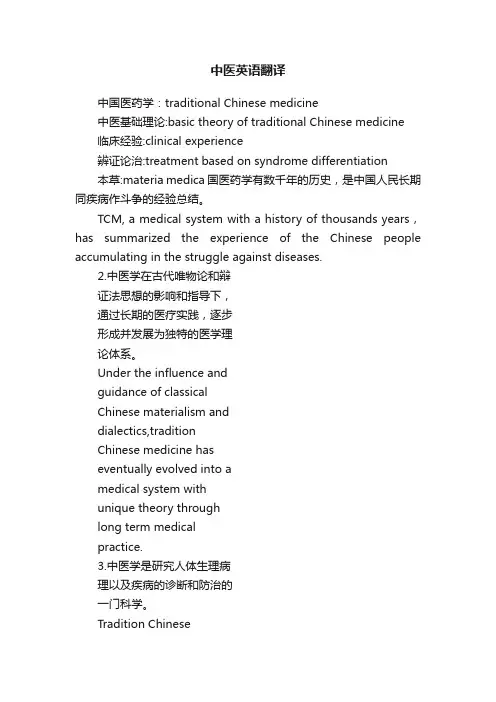
中医英语翻译中国医药学:traditional Chinese medicine中医基础理论:basic theory of traditional Chinese medicine临床经验:clinical experience辨证论治:treatment based on syndrome differentiation本草:materia medica国医药学有数千年的历史,是中国人民长期同疾病作斗争的经验总结。
TCM, a medical system with a history of thousands years,has summarized the experience of the Chinese people accumulating in the struggle against diseases.2.中医学在古代唯物论和辩证法思想的影响和指导下,通过长期的医疗实践,逐步形成并发展为独特的医学理论体系。
Under the influence andguidance of classicalChinese materialism anddialectics,traditionChinese medicine haseventually evolved into amedical system withunique theory throughlong term medicalpractice.3.中医学是研究人体生理病理以及疾病的诊断和防治的一门科学。
Tradition Chinesemedicine is a sciencefocusing on the study ofthe physiology andpathology of the humanbody as well as thediagnosis, prevention andtreatment of disease.4.黄帝内经总结了春秋战国以来的医疗成就和治疗经验,确立了中医学独特的理论体系,成为中医药学发展的基础。
中国中医英文介绍Traditional Chinese Medicine ("TCM") is an integral part of Chinese culture. It has made great contributions to the prosperity of China. Today both of TCM and western medicine are being used in providing medical and health services in China. TCM, with its unique diagnostic methods, systematic approach, abundant historical literature and materials, has attracted many attentions from the international community. TCM is well recognized for its remarkable effectiveness in off setting the side effect caused by the toxic and chemical treatment of cancer cases in the western medical system.In China, TCM is under the administration of State Administration of TCM and Pharmacology. TCM and its development are regulated. National strategies, law and regulations governing TCM are now in place to guide and promote the research and development in this promising industry.TCM is defined as a medical science governing the theory and practice of traditional Chinese medicine. It includes Chinese medication, pharmacology/herbalogy, acupuncture, massage and Qigong.Hospitals in China are classified as specialized in western medical system, TCM or both. TCM is now available to 75% of the areas in China. TCM has been very effective in the treatment of diseases such as cardio-cerebro-vascular, immunogenic, tumors, bone fracture, etc. Scientific research and clinic experiments in TCM are continuously progressing. Successes have been made in many of the areas such as in circulating paths of meridians; in Zheng-syndrome, in diagnostic indexes; in therapeutic principles, in healing emergency patients with shock, acute DIC, acute myocardial infarction and acute renal failure. For treatment of bone fracture, method is adopted based on the theory of combination of mobilization and immobilization. Non-antibacterial compound prescriptions are used successfully in treatment of bacterial infection. In treatment of cancers, Fuzheng Guben compound prescriptions, though devoid of inhibitory effects on cancer cells, could cause the shrink of the mass of cancer. TCM provides a non-surgical approach to the treatment of acute abdomen.CuppingCupping the source ofCupping therapy is a valuable heritage of Chinese medicine, one in Chinese Han people to use a long time. Ge Hong Jin Dynasty medical scientist with the "elbow back-up emergency party" where there are angle method documented. The so-called angle method is the use of hollowing out of the horns to pull abscess aspiration of foreign governing methods. Wang Tao of the Tang Dynasty "Taiwan Miyao," also describes the use of bamboo cupping to cure, such as in the text, said: "... ... take three fingers Daqing bamboo, long Cunban, a left section, no section of the first cut so thin like swords, cook the cheese Number of boiling, and heat out of cartridges, ink points according to the cage, a long time to break the corner cutter bombs, but also re-Kok, cook cheese, when a yellow and white Chishui, sub-a pus out, worm out there who count so Kok, so that out of evil things to do, is that is, except, when the head is also out as light. "angle from the above describedmethod and system of green bamboo cupping of view, China's Jin, Tang Cupping of the era has long been popular.Cupping a comfortable pull Bingti"Cupping" is the private sector is commonly known as cupping therapy, also known as "pulling pipes" or "suction tube." It is the air tank with heat to exclude the use of negative pressure so that sorption in the skin, causing bleeding as a treatment method of the phenomenon. This treatment can be by cold dampness, dredge the meridians, dispel stasis, qi and blood circulation, reduces swelling, pain, diarrhea fever Sida has to adjust the body's yin and yang balance, lifting of fatigue, enhance physical function to achieve the rousing, cure The purpose of the disease. Therefore, many diseases can be treated with cupping therapy. For example: middle-aged, bones and muscles ache common, according to the interpretation of traditional Chinese medicine mostly rheumatoid Such is Life. Cupping Guankou cover their time in the affected area, you can slowly suck the moisture out of lesions, while promoting local blood circulation, to relieve pain, restore function, and consequently treatment of rheumatism, "Bi Tong" bones bitterness and so does not apply.Cupping can do it because of gas-blood circulation, expelling wind and cold-dispelling, reduces swelling, pain, so the back muscle strain, lumbar disc herniation have a certain therapeutic effect. Dr. Lulu's briefing, fire can also be used in the body acupuncture points, the treatment of headache, dizziness, faces badly bruised, coughing, wheezing, abdominal pain and other illnesses, and more than fire can be implemented at the same timeCupping Traditional Chinese Medicine on the principle:Chinese medicine, cupping can be opened to vent Cou science, rousing. Disease is caused by pathogenic factors of yin and yang of the body Piansheng partial decline, the body movements of qi disorders, internal organs caused by blood disorders. When the body is affected by wind, cold, summer heat, wet, dry, fire, poison, trauma or internal injuries invasion blog, you can lead to dysfunctional organs, resulting in pathological product, such as congestion, qi, phlegm, Sushi, water turbid, Xiehuo and so on, these pathological product is pathogenic factors, through the meridians and acupoints to go channeling the body, against the indiscriminate air-stranded organs; deposition resistance in turn, eventually lead to all kinds of illnesses. Cupping resulting vacuum has a strong pull of the suction force, pulling the suction force acting on the meridian points, it can be to open pores and make skin absorption congestion, so that the body's pathological product from the skin pores to suck out of the body, so that able to dredge the meridian qi and blood, so that organs function to be adjusted to achieve the purpose of combating the disease. Chinese medicine, cupping can dredge meridians, adjust blood. Meridians have "blood-line, business yin and yang, Confucianism bones, Lee joint," the physiological functions, such as the meridians are not impeded General through the air, blood stagnation line, there may be skin, flesh, tendons, veins and joints dystrophy and atrophy, adverse , or blood do not wing, Six Hollow Organs were not delivered and so on. By cupping the skin, pores, meridians, acupuncture points of the suction pull the role of anger can lead battalion Wei lost before a cloth, agitation meridians qi, Ru Yang organs tissues and organs, very inviting fur, while virtual decline of the organs function to beexcited, smooth meridian, adjust the body's yin and yang balance so that blood can be adjusted so as to achieve fitness illnesses Liaoji purposes.Western medicine on the principle of cuppingModern medicine, cupping treatment tank role in the formation of negative pressure, so that local capillary congestion and even rupture, rupture of red blood cells, skin congestion, there own hemolysis, then produce a histamine histamine and classes of substances, with the body fluids of weeks Stream body, to stimulate the various organs, to enhance its functional activity, can improve the body's resistance. Modern medicine, cupping negative pressure stimulus, enabling the expansion of local blood vessels, promote blood circulation, improve congestive state, strengthen the metabolism, changes in nutritional status of local organizations to enhance the permeability of blood vessel wall and leukocyte phagocytic activity, enhance the body's physical and human immunity. Modern medicine, cupping pressure on local parts of the suction pull, can speed up the blood and lymph circulation, promote gastrointestinal peristalsis, improving digestive function and promote. Speed up the muscle and internal organs on the Elimination of metabolite excretion.Cupping cans left spot, as well as the significance of colorCommon tank spots are flushing, purple or purplish black ecchymosis, small point-like purple rash, but also often accompanied by varying degrees of heat pain. These changes in the skin are cupping therapy effect, and sustainable one to several days.Cupping, the tank spot, such as noticeable blisters, edema, and water vapor-like, indicating that patients with wet wet Sheng or because of the illness experience.Sometimes, after the blisters Secheng drawing blood red or black and red, indicating that the wet long illness folder pathological response to stasis.Cans dark red spot appears, Zihei or Dan dehydration phenomena, the micro-touch pain, and those who see the body heat, indicating that patients have a heat-toxin syndrome.Such as cans purple or purplish black spot appears, no Dan stasis and heat phenomena, indicating that there is congestion in patients with disease.Can spot-free skin color changes, do not touch the warm, multi-show patients Deficiency Syndrome.In case of micro-itching spot cans or there Piven, the wind's disease patients had more than that.Generally disease-free more than those who had no significant change in tank spot.About Our Massage ServicesMassage is the practice of soft tissue manipulation. It involves acting on the body and manipulating it with pressure. The masseur may use his hands, fingers, elbows, forearm, and even his feet to manipulate the tissue. Target tissues may include muscles, tendons, ligaments, skin, joints, connective tissue, lymphatic vessels, or organs of the gastrointestinal system. In China, massage is widely practiced and taught in hospitals and medical schools and is an essential part of primary healthcare.At Sam’s Massage Center, c lients lie fully clothed on a massage table. If cupping on scraping treatments are requested, the area to be treated is exposed. Full body oil massage requires partial disrobing. Blankets are available to keep the client warm should the client feel cold during the massage.Chinese Medical Massage (Tui Na)Chinese Medical Massage is good if you are experiencing pain in one or more parts of your body, such as neck pain, lower back pain, shoulder pain, slipped discs, sciatic nerve pain, stomach problems (such as indigestion, heartburn, or digestive problems), or intestinal problems. The masseur can give you an all-over massage and focus on specific areas with pain or do a treatment on the affected area. The masseur uses shiatsu, or acupressure, to relieve pain. The masseur may use his thumbs, palms, elbow, and forearm while performing the massage.Sam’s Therapeutic MassageSam’s Therapeutic Massage is a deep tissue, all-over body massage. The masseur uses his thumbs to apply pressure to pressure points in the body, then releases his thumb from the point. You may experience some pain during the application of pressure, but the end result is that you will feel relief when the pressure is released.Deep tissue massage is designed to relieve severe tension in the muscles and connective tissue. This type of massage focuses on the muscles located below the surface of the top muscles. Deep tissue massage is recommended for clients who experience constant pain, are involved in heavy physical activity, or have sustained a physical injury.Special Woman’s MassageOur special woman’s massage concentrates on areas of special concern for woman. The massage consists of a medical massage with attention paid to the pelvic area and the muscles above the breasts.Oil MassageWe use aromatic essential oils and massage techniques similar to Swedish massage. Oil massage consists of broad, circular strokes with no pressure point or deep tissue massage techniques. Oil massage is soothing and a great way to feel relaxed and refreshed. We especially recommend oil massage if you have been having difficulty sleeping.Foot MassageOur foot massage is different from traditional Chinese foot massage in that we perform the massage while the client is recumbent. We do not soak the feet in water but apply hot, wet towels to the feet before starting the massage. We use an emollient cream to soften and moisturize the feet during the massage. The masseur uses reflexology techniques to pinpoint problem areas in your body and improve your health.温馨提示-专业文档供参考,请仔细阅读后下载,最好找专业人士审核后使用!。
中国医药学:traditional Chinese medicine中医基础理论:basic theory of traditional Chinese medicine临床经验:clinical experience辨证论治:treatment based on syndrome differentiation本草:materia medica国医药学有数千年的历史,是中国人民长期同疾病作斗争的经验总结。
TCM, a medical system with a history of thousands years,has summarized the experience of the Chinese people accumulating in the struggle against diseases.2.中医学在古代唯物论和辩证法思想的影响和指导下,通过长期的医疗实践,逐步形成并发展为独特的医学理论体系。
Under the influence andguidance of classicalChinese materialism anddialectics,traditionChinese medicine haseventually evolved into amedical system withunique theory throughlong term medicalpractice.3.中医学是研究人体生理病理以及疾病的诊断和防治的一门科学。
Tradition Chinesemedicine is a sciencefocusing on the study ofthe physiology andpathology of the humanbody as well as thediagnosis, prevention andtreatment of disease.4.黄帝内经总结了春秋战国以来的医疗成就和治疗经验,确立了中医学独特的理论体系,成为中医药学发展的基础。
中医英语翻译中国医药学:traditional Chinese medicine中医基础理论:basic theory of traditional Chinese medicine 临床经验:clinical experience辨证论治:treatment based on syndrome differentiation 本草:materia medica //medicinal herbs中药Chinese herbs四气五味:four properties and five tastes针灸acupuncture and moxibustion各家学说theories of different schools汗法: diaphoresis /diaphoretic therapy下法:purgative therapy吐法:emetic therapy补土派:school of invigorating the earth病因学说:theory of etiology养生:health-cultivation医疗实践medical practice治疗原则:therapeutic principles寒凉药物:herbs of cold and cool nature滋阴降火:nourishing yin to lower fire瘀血致病:disease caused by blood stasis先天之精:congenital essence气的运动变化:movement and changes of qi形与神俱:inseparability of the body and spirit神明: spirit/mental activity脏腑:zang-organs and fu-organs/viscera功能活动:functional activities形神统一:unity of the body and spirit阴阳失调:imbalance of yin and yang正邪相争:struggle between healthy qi and pathogenic factors 治未病prevention of disease调养to cultivate health正气healthy qi病邪pathogenic factor疾病的防治prevention and treatment of disease整体观念concept of holism五脏five zang-organs六腑six fu-organs经络系统system of meridians and collaterals形神统一unity of the body and spirit有机整体organic wholeness表里关系exterior and interior relation开窍opening into生长化收藏five element function脉象pulse conditions正邪关系the states of pathogenic factors and healthy qi自然现象natural phenomena哲学概念philosophical concept对立统一unity and opposites相互消长mutual waning and waxing阴阳属性nature of yin and yang相互转化mutual transformation相互联系interrelation相互制约mutual restraint动态平衡dynamic balance阴平阳秘yin and yang in equilibrium阳消阴长yang waning and yin waxing阴胜则阳病predominance of yin leading to disorderof yang阳胜则热predominance of yang generating heat寒极生热extreme cold generating heat热极生寒extreme heat generating cold相反相成opposite and supplementary to each other 生理功能physiological functions病理变化pathological changes临床诊断clinical diagnosis有机整体organic wholeness/entirety正邪斗争struggle between healthy qi and pathogenic factors绝对偏盛absolute predominance阳虚则寒yang deficiency leading to cold阳损及阴consumption of yang involving yin阴液不足insufficiency of yin-fluid病机pathogenesis五行学说theory of five elements运动变化motion and variation条达舒畅free development相生相克mutual generation and restriction生我我生to be generated and to generate克我我克to be restricted and to restrict生中有制restriction within generation克中有生generation within restriction木曰曲直Wood is characterized by growing freely and peripherally火曰炎上Fire is characterized by flaming up土曰稼穑Earth is characterized by cultivation and reaping金曰从革Metal is characterized by change水曰润下Water is characterized by moistening anddownward flowing方位配五行correspondence of the directions to the five elements相乘相侮over-restriction and reverse restriction土乘木The wood over-restrains the earth土虚木乘Earth deficiency leading toover-restriction by wood金虚木侮metal deficiency leading tocounter-restriction by wood生克制化interrelationship between generation and restriction制则生化restriction ensuring generation传变transmission of disease母病及子disease of the mother-organ affecting the child-organ子病犯母disease of the child-organ affecting the mother-organ肝肾精血不足insufficiency of kidney and liver essence and blood肝阳上亢hyperactivity of liver yang藏象学说theory of visceral manifestations五脏六腑five zang-organs and six fu-organs奇恒之府extraordinary fu-organs水谷精微cereal nutrients传化水谷transmissions and transformation of food 贮藏精气storage of essence表里关系interior and exterior relationship治疗效应curative effect临床实践clinical practice藏而不泻storage without excretion心肝血虚deficiency of heart and liver blood心肝火旺exuberance of heart and liver fire心火亢盛exuberance of heart fire滋肾养肝nourishing the kidney and liver肝阴不足insufficiency of the liver yin温肾健脾warming the kidney and strengthening the spleen肾阳式微declination of kidney yang脾阳不振inactivation of spleen yang肝旺脾虚hyperactivity of the liver and weakness ofthe spleen脾胃虚弱weakness of the spleen and stomach平肝与胃soothing the liver and harmonizing the stomach水湿停聚retention of water-dampness肾阴不足insufficiency of kidney yin心肾不交disharmony between the heart and kidney水火不济discordance between water and fire阴阳俱损simultaneous consumption of yin and yang阴阳两虚simultaneous deficiency of both yin andyang损其有余reducing excess补其不足supplementing insufficiency阴中求阳obtaining yang from yin虚寒证deficiency-cold syndrome扶阳益火strengthening yang to increasing fire祛风散寒eliminating wind to dispersing cold消导积滞promoting digestion and removing food retention 潜阳息风suppressing yang to quench wind阴阳的互根互用interdependence of yin and yang相互依存interdependence阴阳离决separation of yin and yang阴阳转化transformation between yin and yang发热恶寒fever and aversion to cold头身疼痛headache and body pain感受湿邪the attack of dampness清热泄火cleaning away heat and reducing fire腠理muscular interstices水湿停滞retention of water and dampness气血运行circulation of qi and blood疾病的本质与现象:nature and manifestations of disease阴阳的相对平衡:relative balance between yin and yang疾病的发生与发展:occurrence and development of disease同病异治:treating the same disease with different therapies 异病同治:treating different diseases with the same therapy1、中国医药学有数千年的历史,就是中国人民长期同疾病作斗争的经验总结。
中医英语术语-CAL-FENGHAI.-(YICAI)-Company One1第一课1.中国中医药traditional Chinese medicine; TCM中医基础理论basic theory of traditional Chinese medicine临床经验clinical experience辨证论治treatment based on syndrome differentiation 杂病miscellaneous diseases中药学Chinese pharmacy 四气五味four properties and five tastes针灸acupuncture and moxibustion; acumox古代中国哲学classical Chinese philosophy汗法sweating therapy; diaphoresis 下法purgation吐法vomiting therapy; emetic therapy补土派the School of Reinforcing the Earth方剂prescription; formula医疗实践medical practice治疗原则therapeutic principles寒凉药herbs cold and cool in nature滋阴降火nourishing yin and reducing fire瘀血致病diseases caused by blood stagnation第二课1 ve zang-organs; five zang-viscera五脏six fu-organs六腑system of meridians and collaterals经络系统holism整体观念organic wholenss有机整体social attribute社会属性(of the five zang-organs) open into开窍sprout, grow, transform, ripen and store生长化收藏diagnostics诊断学relationship between pathogenic factors and healthy qi邪正关系therapeutics治疗学common cold due to wind and cold风寒感冒different therapeutic methods used to treat the same disease同病异治the same therapeutic method used to treat different diseases异病同治balance of water metabolism水液代谢平衡clearing away heart fire清心火nature of disease疾病本质treating the left side for curing diseases located on the right side 以左治右drawing yang from yin从阴引阳treating the lower part for curing diseases located on the upper part病在上者下取之第三课1 philosophical concept哲学概念mutual transformation相互转化balance of yin and yang阴平阳秘transformation between yin and yang阴阳转化extreme cold turning into heat寒极生热pathological changes病理变化absolute predominance 绝对偏盛general rule of pathogenesis病机总纲supplementing what it lacks of补其不足eliminating wind and dispersing cold祛风散寒mutually inhibiting and promoting相互消长mutually inhibiting and restraining相互制约interdependence相互依存excess of yin leading to decline of yang阴胜则阳病contrary and supplementary to each other相反相成organic whole有机整体impairment of yang involving yin阳损及阴deficiency of both yin and yang阴阳两虚deficiency cold syndrome虚寒证suppressing yang and eliminating wind熄风潜阳第四课1.the doctrine of five elements; the theory of five phases五行学说free development 条达舒畅to be generated and togenerate生我我生restraint in generation生中有制Wood is characterized by growing freely and peripherally.木曰曲直Earth is characterized by cultivation and reaping.土元稼穑Water is characterized by moistening and downward flowing.水曰润下over restriction and counter-restriction相乘相侮Wood over restricts earth because it is deficient.土虚木乘promotion, restriction, inhibition and transformation生克制化disorder of a mother-organ involving its child-organ母病及子insufficiency of essence and blood in the liver and kidney肝肾精血不足blood deficiency in the heart and liver心肝血虚exuberant fire in the heart心火亢盛insufficiency of liver yin肝肾不足declination of kidney yang肾阳衰微weakness of the spleen and stomach脾胃虚弱soothing the liver and harmonizing the stomach平肝和胃 insufficiency of kidney yin肾阴不足balance between water and fire水火不济第五课doctrine of visceral manifestations脏象学说five zang-organs and six fu-organs五脏六腑extraordinary fu-organs齐桓之府nutrients of water and food水谷精微ransmitting and transforming water and food传化水谷storing essence贮藏精气internal and external relationship表里关系therapeutic effects治疗效应clinical practice临床实践storage without discharge藏而不写discharge without storage泻而不藏physical build and various orifices形体诸窍(of five zang-organs) open into开窍spirit and emotions精神情志the heart storing spirit心藏神the lung storing corporeal soul肺藏魄the liver storing ethereal soul肝藏魂the spleen storing consciousness 脾藏意the kidney storing will肾藏志the luster manifesting upon the face其华在面第六课the heart governing blood and vessels心主血脉sufficiency of heart qi心气充沛rosy complexion面色红润sufficiency ofblood血液充盈unsmooth vessels脉道不利lusterless complexion面色无华thin and weak pulse脉象细弱the heart storing spirit心藏神sweat and blood sharing the same origin汗血同源ascending, descending, going out and going in升降出入dispersion, purification and descent宣发肃降regulating water passage通调水道the spleen governing transportation and transformation脾主运化nutrients of water and food水谷精微stoppage of water and fluid水液停滞acquired base of life 后天之本regulating qi activity调畅气机upward adverse flow of liver qi肝气上逆innate essence先天之精the kidney receiving qi肾主纳气第七课extraordinary fu-organs齐桓之府isolated fu-organ孤府digest water and food腐熟水谷anus破门remaining part of liver qi肝之余气upper energizer上焦separating the lucid from the turbid泌别清浊residue of foods食物残渣The large intestine governs thin body fluid大肠主津bile精汁The small intestine governs thick body fluid小肠主液primary digestion初步消化essential qi精气the seven important portals七冲门The gallbladder is responsible for making judgment胆主决断discharge waste排泄糟粕occurrence of menstruation月经来潮epiglottis 吸门morphological hollowness形态中空transporting and transforming water and food传化水谷第八课innateness先天禀赋nutrients; refined substance精微物质blood circulation血液循环water metabolism水液代谢way of qi movement气的运动形式ascending, descending, exiting and entering movements of qi的升降出入运动normal function of qi activity气机条畅primary motive force of life生命的原动力warming and nourishing the viscera温养脏腑qi of the viscera and meridians脏腑经络之气qi activity气机qi transformation气化innate qi先天之气acquired qi 后天之气healthy qi正气pathogenic factors邪气primordial qi元气thoracic qi宗气nutritive qi营气defensive qi卫气第九课qi promoting the production of blood气生血qi promoting the flow of blood气行血qi commanding blood气摄血blood carrying qi血载气blood generating qi血生气qi promoting the production of body fluid气生津液qi promoting the flow of body fluid气行津液qi commanding body fluid气摄津液body fluid carrying qi津液载气body fluid generating qi津液生气body fluid and blood sharing the same origin津血同源exhaustion of qi due to loss of body fluid气随液脱exhaustion of qi due to hemorrhage 气随血脱loss of qi due to profuse sweating气随津泄Normal flow of qi ensures normal flow of blood while stagnation of qi causes stagnation of blood.气行则血行气滞则血瘀Qi commands the blood and the blood carries qi.气为血帅血为气母Normal flow of qi ensures normal flow of body fluid while stagnation of qi causes stagnation of body fluid.气行则水行气滞则水滞nourishing qi to stop collapse益气固脱Sweating therapy should be not be used to treat patients suffering from hemorrhage.亡血家不可发汗Sweating therapy should not be used to treat hemorrhage.夺血者无汗第十课theory of meridians and collaterals经络学说system of meridians and collaterals经络系统transporting qi and blood to the whole body运行全身气血being connected with the viscera and limbs联络脏腑肢节running routes循行路线twelve regular meridians十二正经the regions through or along which the meridians run and the order by which the meridians are connected with each other循行部位和交接顺序(of a collateral) pertaining to a certain meridian络属关系eight extraordinary vessels (meridians)奇经八脉branches of the twelve regular meridians十二经别divergent collaterals别络skin divisions of the twelve regular meridians十二皮部tendons of the twelve regular meridians十二经筋qi of meridians经络之气syndrome differentiation of meridians and collaterals经络辨证meridian conduction经络感传meridian manifestations经络现象blockage of meridians经络阻滞soothing meridians and activating collaterals舒筋活络collateral pricking and cupping therapy刺络拔罐第十课theory of meridians and collaterals经络学说system of meridians and collaterals经络系统transporting qi and blood to the whole body运行全身气血being connected with the viscera and limbs联络脏腑肢节running routes循行路线twelve regular meridians十二正经the regions through or along which the meridians run and the order by which the meridians are connected with each other循行部位和交接顺序(of a collateral) pertaining to a certain meridian络属关系eight extraordinary vessels (meridians)奇经八脉branches of the twelve regular meridians十二经别divergent collaterals别络skin divisions of the twelve regular meridians十二皮部tendons of the twelve regular meridians十二经筋qi of meridians经络之气14 syndrome differentiation of meridians and collaterals经络辨证meridian conduction经络感传meridian manifestations经络现象blockage of meridians经络阻滞soothing meridians and activating collaterals舒筋活络collateral pricking and cupping therapy刺络拔罐Lesson 11six exogenous pathogenic factors外感六淫improper diet and overstrain 饮食劳倦common cold due to wind-cold风寒感冒diarrhea due to damp-heat/damp-heat diarrhea 湿热泄泻five endogenous pathogenic factors内生五邪pathogenic wind attacking the exterior 风邪外袭migratory arthralgia/joint pain游走性关节痛wind being the leading pathogenic factor风为百病之长 attacked/invaded by pathogenic cold感受寒邪decline of yang qi阳气衰退 cold tending to stagnate by nature寒性凝滞 stagnation of interstitial space 腠理闭塞spasm and contraction of muscles and tendons经脉拘急收引pathogenic dampness obstructing the spleen湿邪困脾inactivation of spleen-yang脾阳不振production of endogenous heat due to yin deficiency阴虚生内热extreme heat producing wind热极生风internal impairment due to yin deficiency 七情内伤improper diet饮食不节engorgement 暴饮暴食Lesson 12occurrence, development, and changes of disease疾病的发生发展变化(body )constitutional state 体质强弱dysfunction of qi and blood气血功能紊乱various pathological changes多种多样的病理变化exuberance or decline of pathogenic factors and healthy qi/ strength contrast between pathogenic factors and healthy qi邪正盛衰deficiency or excess changes of disease /transformation between deficiency and excess during a disease病症的虚实变化the human body’resistance against diseases 人体的抗病能力feverish sensation over the five centers (palms, soles, and chest)五心烦热deficiency complicated with excess虚实夹杂turnover of disease/prognosis of disease疾病转归 relative predominance of yin or yang 阴阳偏盛extreme changes of five emotions五志过极depletion of essence causing deficiency精气夺则虚mutual consumption of yin and yang阴阳互损true heat and false cold; false cold and true heat真热假寒或假寒真热stagnation of qi activity气机瘀滞不畅disorder of fluid metabolism津液代谢失常endogenous cold/ cold originating from the interior 寒从中生fluid consumption producing dryness津伤化燥stirring of endogenous wind/disturbance of endogenous wind风气内动Lesson 13spirit, complexion, and physical conditions 神色形态mental activities 精神活动sufficient essence and abundant qi精气充足apathetic facial expressions表情淡漠 normal complexion and varied normal complexion 主色与客色convulsion of the limbs四肢抽搐stirring of wind due to damp-heat湿热风动interior sinking of pathogenic toxin邪毒内陷scaly skin/ squamous and dry skin肌肤甲错hunger without appetite饥不欲食combined use of the four diagnostic methods四诊合参facial expressions面部表情favorable prognosis预后良好dispiritedness 精神不振five colors indicating diseases / diagnostic significance of five colors五色主病 facial distortion口角歪斜flaming of deficient fire虚火上炎retention of heat in the large intestine大肠热结mirror-like tongue光剥舌pulse manifestations脉象Lesson 14prevention before occurrence未病先防harmony between qi and blood气血平和regulating mental conditions调摄精神smooth circulation of blood血脉流畅smooth movement of joints关节通利smooth flow of qi/ free activity of qi气机条畅prolonging life and promoting longevity益寿延年preventive and therapeutic principles防治原则treatment should focus on the root of diseases治病求本treating secondary symptoms in acute disease急则治其标treating primary symptoms in chronic disease缓则治其本simultaneous treatment of primary and secondary symptoms 标本兼治deficiency of healthy qi and excess of pathogenic factors正虚邪实removing parasites to eliminate accumulation驱虫消积accumulation of phlegm-dampness in the lung痰湿壅盛blood serving as the mother of qi血为气母treatment in accordance with seasons, locality and individuality.因时因地因人制宜avoiding cold herbs in cold weather用寒远寒exogenous dry disease in autumn 外感秋燥moistening dryness with pungent and cool herbs辛凉润燥Lesson 15ⅰ.treatment with syndrome differentiation/ 辨证论治disease involving both exterior and interior表里同病 simultaneous occurrence of cold and heat/ mixture of cold and heat寒热错杂regression of interior pathogenic factors to the exterior 里邪出表true cold and false heat 真寒假热aversion to cold and aversion to heat恶寒与恶热tasteless sensation in the mouth without thirst 口淡不渴transformation of stagnated pathogenic cold into heat 寒邪郁而化热exterior-deficiency syndrome due to exogenous pathogens外感表虚feverish sensation over five centers五心烦热location and nature of disease病位与病性mixture of deficiency and excess虚实夹杂invasion of exterior pathogenic factors into the interior表邪入里cold syndrome transforming into heat syndrome寒症化热true heat and false cold真热假寒heat syndrome transforming into cold syndrome热证转寒pale tongue with white, moist and slippery fur舌淡苔白而润滑rapid and weak pulse脉数无力tidal fever and night sweating 潮热盗汗coma with delirium神昏谵语 Lesson 16Chinese medicinal herbs 中草药four properties and five flavors 四气五味the part used for medical purpose入药部分collection of herbs药物采集processing of herbs 炮制eliminating impurity清除杂质mild effect作用和缓relieving exterior syndrome by dispersion发散解表astringing and checking收敛固涩lubricant purgation by softening hardness 软坚润下drying dampness to invigorate the spleen燥湿健脾ascending, descending, sinking and floating升降沉浮channel tropism/channel distribution of medicines归经medication contraindication用药禁忌dosage药物剂量pungent and warm herbs with the function of relieving exterior syndrome 辛温解表药herbs for expelling wind and dampness祛风湿药eighteen incompatible herbs and nineteen herbs of mutual antagonism十八反十九畏herbs for clearing away heat and cooling blood清热凉血药herbs foreliminating phlegm and stopping cough祛痰止咳药Lesson 17Science of prescription方剂学compatibility配伍关系prescription-formulating principle组成规律modification of prescriptions方剂的加减drug form and dosage 剂型与剂量monarch, minister, assistant and guide君臣佐使toxicity of medicinal herbs药物毒性 moderating the property of herbs 缓和药性guiding action引经报使mediating all herbs in a prescription调和诸药warming channels to dissipate cold温经散寒dispersing lung to relieve asthma宣肺平喘flexible modification灵活化裁clearing away and dispersing stagnated heat 清散郁热modification according to symptoms随症加减processed herbs药物饮片power for oral taking内服散剂medicinal extract for external application 外用膏剂mixed in boiled water for oral taking开水冲服condensed extract浓缩浸膏 Lesson 18acupuncture and moxibustion therapy针灸疗法reinforcing and reducing techniques for needling针刺补泻needling techniques针刺手法methods for needle-inserting进针手法alleviating pain with acupuncture针刺止痛acupuncture anesthesia针刺麻醉needling sensation 针感intradermal needle皮内针angle and depth of needling针刺的角度和深度insertion of needle with double hands双手进针 manipulation of needle行针ear acupuncture therapy耳针疗法lifting, thrusting, twisting and rotating 提插捻转water-acupuncture therapy水针疗法scalp-acupuncture therapy头针疗法blistering moxibustion 化脓灸scarring moxibustion瘢痕灸moxibustion with moxa cone艾炷灸 lamp moxibustion灯火灸needle-warming moxibustion温针灸Lesson 19tuina manipulations推拿手法alleviating pain减轻疼痛exercise for practicing tuina功法训练relaxing muscles放松肌肉relieving muscular tension解除肌肉紧张restricted activity活动受限dislocation of joint关节脱位protrusion of lumbar vertebral disc腰椎间盘突出rotating reduction旋转复位injury of soft tissue软组织损伤adhesion and stiffness of joint 关节粘连僵硬lubricating joint滑利关节reinforcing and reducing manipulation手法补写horizontal pushing with the thumb拇指平推法pushing manipulation with one finger一指禅推法point-pressing manipulation点按法kneading manipulation with the large thenar大鱼际揉法alternated rubbing and kneading交替搓揉injury of lumbar muscles腰肌劳损vertical exertion of force 垂直用力Lesson 20differentiation of tongue manifestations辨舌象differentiation of pulse manifestations辨脉象balancing expelling pathogenic factors with strengthening healthy qi 正邪兼顾thoracic retention of fluid支饮chills in the back/aversion to cold in the back背部恶寒dark complexion/black complexion面色黧黑slippery tongue coating/ moist and glossy tongue coating舌苔水滑taut pulse/wiry pulse 弦脉dispelling pathogenic cold发散寒邪invigorating the stomach to resolve fluid健胃化饮nourishing kidney water to astringe lung qi滋肾水以敛肺气nourishing yin blood to protect liver yin养阴血以护肝阴expelling pathogenic factors without impairing the healthy qi祛邪而不伤正invigorating qi to harmonize the middle-jiao益气和中mediating all herbs in a prescription调和诸药prescriptions for drastic diaphoresis发汗峻剂cold in the exterior and fluid in the interior表寒里饮cold water attacking the stomach水寒犯胃effective prescriptions有效方剂cold limbs in syncope 手足厥冷Lesson 21complementary therapy补充疗法alternative medicine 替代医学rehabilitation process康复过程side-effects副作用active ingredients 有效成分evidence-based data 询证数据double-blind randomized trial双盲随机试验stroke onset中风发病hyper-acute stage超急性期proprietary medicine 专利药品animal models动物模型risk of bleeding出血的危险因素mechanism of action作用机制low-quality medical treatments医疗质量低下 physiotherapy物理疗法 neuroplasticity 神经可塑性mainstream medicine 主流药物antiplatelet agent抗血小板剂microbial analysis微生物分析heavy metal research 重金属研究。
Lesson11.中国医药学traditional Chinese medicine; TCM 2.中医基础理论basic theory of TCM 3.临床经验clinical experience 4.辨证论治treatment based on syndrome differentiation 8.针灸acupuncture and moxibustion 14.病因学etiology19.滋阴降火nourishing yin and reducing fire1. 中国医药学有数千年的历史,是中国人民长期同疾病作斗争的经验总结。
TCM has a history of thousands of years and is a summary of the Chinese people’s experience in t heir struggle against diseases.2. 中医学有完整独特的理论体系。
TCM has a unique and integrative theoretical system.4.《黄帝内经》为中医学理论体系的形成奠定了基础。
Huangdi’s Inner Canon of Medicine has laid a foundation for the formation of theoretical system of TCM.7.阳常有余,阴常不足。
Yang is usually excessive while yin is frequently deficient.8.内伤脾胃,百病由生。
Internal impairment of the spleen and stomach causes various diseases.11.金元时期出现了后世称为“金元四大家”的医学流派。
In the Jin and Yuan Dynasties, there appeared the so-called “four great physicians” in medical s chool.12.张从正认为病由邪生,提倡汗、吐、下三法祛邪治病。
1 总论序号汉文名英文名注释中医①traditional Chinese medicine②traditional Chinese physician ①中医学的简称。
②本学科专业职业队伍。
中药Chinese materia medica 在中医理论指导下应用的药物。
包括中药材、中药饮片和中成药等。
中医学traditional Chinese medicine 以中医药理论与实践经验为主体,研究人类生命活动中健康与疾病转化规律及其预防、诊断、治疗、康复和保健的综合性科学。
中药学Chinese materia medica 中药学科的统称。
研究中药基本理论和各种药材饮片、中成药的来源、采制、性能、功效、临床应用等知识的学科。
中医药traditional Chinese medicine and pharmacology 中医与中药的合称。
中医药学traditional Chinese medicine and pharmacology 中医学与中药学的合称,侧重反映中医与中药两者共同发展,密不可分。
中西医结合integration of traditional and western medicine 现代医学等现代科学知识及手段来继承和发展中医药,中西医学相互补充,取长补短,诊治疾病的医学形式。
中医基础理论basic theory of traditional Chinese medic ine 研究和阐明中医学的基本概念、基本理论、基本规律、基本原则的学科。
中医诊断学diagnostics of traditional Chinese medic ine 根据中医学的理论体系,研究诊察病情、判断病种、辨别证候的基础理论、基本知识和基本技能的学科。
方剂学prescriptions of Chinese materia medica 研究治法与方剂配伍规律及其临床运用的学科。
中医内科学internal medicine of traditional Chinese medicine 研究外感温病、内伤杂病等内科疾病诊治与预防的临床中医学。